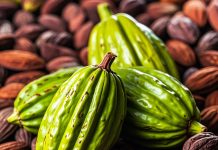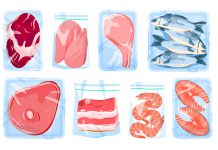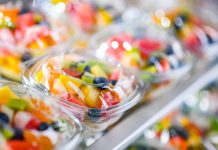The winemaking industry is wide represented in Republic of Moldavia and Romania. The processing of grapes leads to about 70% wine and almost 30% by-products (grape marc). Nowadays, more than ever, there is a need to elaborate low-cost and efficient technologies for the valorisation of under-used by-products. Important amounts of phenolics from grapes remain in the marc. Grape phenolic compounds like: hydroxycinnamic acids (caffeic, coumaric, caftaric, ferulic), flavanols (catechin, epicatechin), flavonols (quercetin) (Muselík et al., 2007), exhibit health-promoting properties as prevention of carcinogenesis and heart diseases, which are mainly associated to their antioxidant activities (Di Castelnuovo et al., 2002). Due to the content of phenolics, grape marc can be considered a low-cost source of natural compounds with antioxidant and antimicrobial properties, which can be used in the fabrication of functional foods. A particular category of food is represented by sweets, including jelly candies, which are enjoyed by a large number of people, especially by children. Most of jelly candies are prepared with synthetic dyes as azorubine (E 122), which has as possible effects on human health: allergic reactions, intensifying of asthma symptoms, intolerance in people sensitive to salicylates, children hyperactivity and are suspected for carcinogenic properties (connected to urinary bladder cancer). The eventual replacement of the synthetic dye with natural one completely eliminates all these potential risks. The aim of our research was the fabrication at laboratory level of jelly candies using grape marc, in order to replace the synthetic dye and also to beneficiate form the antimicrobial and other health-protecting properties of polyphenols.
Materials and methods
The marc was obtained from Vitis Labrusca cv. “Isabella” grapes. After crushing and pressing, the juice was removed and the waste was immediately dried (in order to avoid oxidation and fermentation), grinded and sieved to a fine powder. The dried marc was subjected to extraction (1:8 ratio) with ethanol 50% on the water bath, under shaking. After filtration and solvent removal we obtain a paste which was kept in the dark at 5.0 ± 1.0 °C prior to be included in the fabrication of jelly candies. Two categories of jelly candies were prepared: classical with synthetic dye E122 and non-conventional with marc. Ingredients for classical candies: sugar, molasses, corn starch, gelatine, sorbitol, citric acid, water and azorubine (E 122) 0.03%; ingredients for non-conventional jelly candies: same, except azorubine, which was replaced with different concentrations of marc extracts (1.0%, 1.5%, 2.0%). The preparation procedure followed the common recipe (www.chefsteps.com/activities/gummy-bears) and the products were packed under vacuum and stored in refrigerator at 5.0 ± 1.0ºC. The physicochemical indicators of the three types of non-conventional candies were compared with the classical with azorubine (used as reference) and with the Moldavian standards according to the legislation (Directive 2000/36/EC): mass fraction of dry weight, mass fraction of reducing substances, titratable acidity and organoleptic indices (BS ISO 6658-2005). The total number of germs (TNG) was compared to the admitted values (Regulation of EC no. 2073/2005 and Regulation of EC no 1441/2007.). In vitro antiradical activity (DPPH•) of candies was appreciate after gastric digestion (Monsen model: pH = 2.0 ± 0.1 (1.5 M HCl), temperature = 37.0 ± 0.1ºC, pepsine (150 mg / 100 g product), duration of incubation: 2 h, vortex 43 g) (Miller et al., 1981). The samples were centrifuged at 4307 g for 10 min and filtered. Analytical methods used for the characterisation of marc extract and jelly candies: antiradical power – DPPH method (Brand-Williams et al., 1995 with modifications); total phenols – two methods: (1) Folin-Ciocalteu (Waterman et al., 1994) and (2) D280, direct reading of the sample absorbance at 280 nm (Ribereau-Gayon et al., 2006); tannins – Folin-Ciocalteu (Waterman et al., 1994), anthocyanins – difference of pH (Amendola et al., 2010). Variance analysis of the results was carried out by least square method with application of Student coefficient and Microsoft Office Excel program. Differences were considered statistically significant if probability was bigger than 95 % (p-value <0.05). All assays were performed in triplicate at room temperature, 20 ± 1oC. Experimental results are expressed as mean ± SD (standard deviation). 
Results and discussions
The content of some bioactive compounds from phenols family and the DPPH• antiradicalic activity of the hydroalcoholic marc extract are presented in Table 1.
Table 1. Content of bioactive compounds and antiradicalic activity of grape marc extract
| Total phenols,
mg GAE/g d.w. |
Total phenols (D280),
mg GAE/g d.w. |
Anthocyanins, mg/g d.w. | Tannins,
mg TAE/g d.w. |
Antiradicalic activity, % |
| 12.89 ± 0.59 | 14.72 ± 0.12 | 0.97 ± 0.10 | 1.32 ± 0.07 | 84.57±0.58 |
The results confirm the presence of valuable health-promoting bioactive substances. Dry weight of jelly candies was analysed after 5 and 50 days from the production date, in order to evaluate modifications during storage (Fig. 1 A). Dry weight increases when the concentration of marc extract added to the candies is more important, but decreases during storage 50 days with about 2% (probably due to the sorbitol, which is a humectant, and to the relative humidity of the refrigerator, the latter being non-adjustable). At both moments (5th day and 50th day), all marc containing candies show superior dry weight content than azorubine containing candies.

Mass fraction of reducing substances has a slight increase (from 13.55 % to 15.09 %) at the replacement of azorubine with marc extract and the increase is insignificant when the marc concentration is enhanced (from 15.09 % to 15.16 % and 15.29 %) (data not represented). Acidity registers a slight increase during storage (from 5 days to 50 days) and a small increase in the presence of marc extract, compared to azorubine. The increase of marc concentration causes insignificant augmentation of acidity (Fig. 1 B). The total number of germs (TNG) diminishes when marc extract is added and the decrease is more important when the marc concentration increases, confirming its antimicrobial activity (Fig. 2). All types of jelly candies, both in 5th and 50th day, contain TNG in the limit of regulated allowed value (max 1×103) (Regulation of EC no.2073/2005 and Regulation of EC no. 1441/2007).


The organoleptic profile of marc containing jelly candies is superior to the azorubine one and the best organoleptic result was obtained for the 1.5% marc extract (Fig. 3). Our results prove that both the 5th day and 50th day, all the analysed indicators (physicochemical, microbiological and organoleptic) of the marc containing jellies correspond to regulated allowed values. Gastric digestion was simulated in vitro previous to analyse the DPPH• antiradical activity. The candies containing azorubine have no antiradical activity and even exhibit a pro-oxidant action (data not shown). Contrary, the candies containing marc extract exhibit antiradicalic activity, which enhances with the augmentation of marc concentration in jelly, reaching 40.78 ± 1.20 % for marc 2 %, fact which reveals the health advantage of replacing the synthetic dye azorubine with marc extract.
Conclusions
- All physicochemical properties of marc jellies correspond to the permitted values by the confectionery rules.
- Characteristics after 5 and 50 days of storage are better for marc jellies comparing with azorubine ones.
- Marc containing jelly candies have important antiradical activity, beneficial for consumer health and also have special organoleptic properties.
- The low-cost and easy fabrication technology, combined with the superior characteristics, recommend the hydroalcoholic extract of grape marc as natural dye and functional ingredient in order to expand the assortment of jelly candies and even to replace the azorubine ones, thus removing the long term side effects of synthetic dyes.
Acknowledgement: The authors would like to thank the project AUF BECO-2012-53-U-56135FT205.
1Faculty of Technology and Management in Food Industry, Technical University of Moldova, Chisinau, Republic of Moldova
2Faculty of Horticulture, University of Agricultural Sciences and Veterinary Medicine “Ion Ionescu de la Brad”, Iaşi, Romania
References
Amendola, D., De Faveri, D. M., Spigno, G., 2010. Grape marc phenolics: Extraction kinetics, quality and stability of extracts. Journal of Food Engineering 97(3), 384-392.
Brand-Williams, W., Cuvelier, M.E., Berset, C. 1995. Use of free radical method to evaluate antioxidant activity. Lebensm Wiss Technology 28, 25–30.
BS ISO 6658-2005 – Sensory Analysis – Methodology – General guidance
Di Castelnuovo, A., Rotondo, S., Iacoviello, L., Donati, M. B., de Gaetano, G. (2002). Meta-analysis of wine and beer consumption in relation to vascular risk. Circulation, 105(24), 2836-2844.
Directive 2000/36/EC of European Parliament and Council /23 June 2000, relating to cocoa and chocolate products, published in the O. J. of the E.U., L 197, 3.8.2000, 19-25.
www.chefsteps.com/activities/gummy-bears (access 29.05.2015)
Miller, D.D., Schricker, B.R., Rasmussen, R.R., Van Campen, D., 1981. An in vitro method for estimation of iron availability from meals. The American Journal of Clinical Nutrition 34(10), 2248-2256.
Muselík, J., García-Alonso, M., Martín-López, M. P., Žemlička, M., Rivas-Gonzalo, J.C., 2007. Measurement of antioxidant activity of wine catechins, procyanidins, anthocyanins and pyranoanthocyanins, International Journal of Molecular Science 8(8), 797-809.
Regulation of EC no.2073/2005 of EC / 15 Nov. 2005 on microbiological criteria for foodstuffs, published in OJ L 338 of the EU /22 Dec. 2005, 1-26.
Regulation of EC no. 1441/2007, 5 December 2007 amending Regulation (EC) nr.2073 / 2005 on microbiological criteria for foodstuffs, published in EU OJ, L 322 of 7 December 2007 Government Decision no. 221 of 16.03.2009, OJ no. 59-61 / 272 of 24.03.2009
Ribéreau-Gayon, P., Dubourdieu, D., Donèche, B., Lonvaud, A., 2006. Handbook of enology. The microbiology of wine and vinifications, Vol. 1, John Wiley & Sons.
Waterman, P. G., Mole, S., 1994. Analysis of phenolic plant metabolites. Blackwell Scientific.
by Aliona Ghendov-Moşanu1, Rodica Sturza1, Elena Chiriţa1, Antoanela Patraş2*




